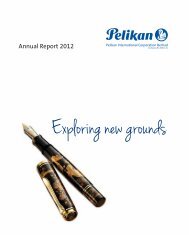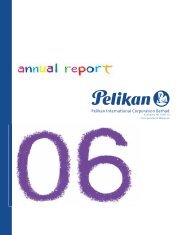annual report 2008 Pelikan Holding AG
annual report 2008 Pelikan Holding AG
annual report 2008 Pelikan Holding AG
You also want an ePaper? Increase the reach of your titles
YUMPU automatically turns print PDFs into web optimized ePapers that Google loves.
<strong>Pelikan</strong> Group<br />
Currency translation<br />
The balance sheets of the foreign companies have been translated at year-end exchange rates. The profit and<br />
loss accounts have been translated at the average exchange rates ruling during the year. The differences<br />
resulting from utilization of differing exchange rates for the translation of balance sheets and profit and loss<br />
accounts are applied to shareholders' equity. The exchange rates used are as follows:<br />
<strong>2008</strong> 2007<br />
Year-end rate Average rate Year-end rate Average rate<br />
CHF CHF CHF CHF<br />
1 EUR 1.49 1.58 1.66 1.64<br />
1 USD 1.06 1.07 1.13 1.19<br />
1 MYR 0.30 0.32 0.34 0.35<br />
100 MXN 7.74 9.69 10.34 10.93<br />
1 ARS 0.31 0.34 0.36 0.37<br />
Consolidation method<br />
The consolidation is based on the purchase method. The shares of third parties in the equity and in the result<br />
for the year of the consolidated companies have been calculated at the balance sheet date and are shown<br />
separately in the balance sheet and profit and loss account as minority interest.<br />
Consolidation adjustments<br />
The sales, expense/ income and receivables/ payables between the consolidated companies and the profits<br />
arising from the intercompany transactions have been eliminated. In those cases where group companies have<br />
given guarantees in respect of the liabilities of other consolidated companies, the contingent liabilities shown<br />
in the individual balance sheets become irrelevant in view of the disclosure of the primary liabilities in the<br />
consolidated financial statements.<br />
Valuation policies<br />
Cash<br />
Cash includes cash on hand, postal checking, bank account balances and time deposits.<br />
Receivables<br />
Trade receivables and other short-term receivables are shown at invoiced amounts less appropriate provisions<br />
for debtors’risks. Specific provisions for doubtful debts are accounted for where required and deferred credit<br />
risks are also considered.<br />
Inventories<br />
The inventories are valued primarily at the lower of average purchase or manufacturing costs and net realizable<br />
value and are stated net of deduction of provisions for obsolescence risks.<br />
Tangible fixed assets<br />
Tangible fixed assets are stated at their acquisition or manufacturing costs less accumulated depreciation.<br />
Yearly impairment tests are made and the appropriate charge, if any, is booked to income statement. Inflationrelated<br />
revaluations of fixed assets in countries with high inflation rates have been made and are also included<br />
in the Financial Statements II which are used for consolidation. These revaluations are not taken to income<br />
statement but are included under the balance sheet heading “Revaluation reserve”. All profit or loss from<br />
disposals of tangible fixed assets is booked to income statement.<br />
23
















